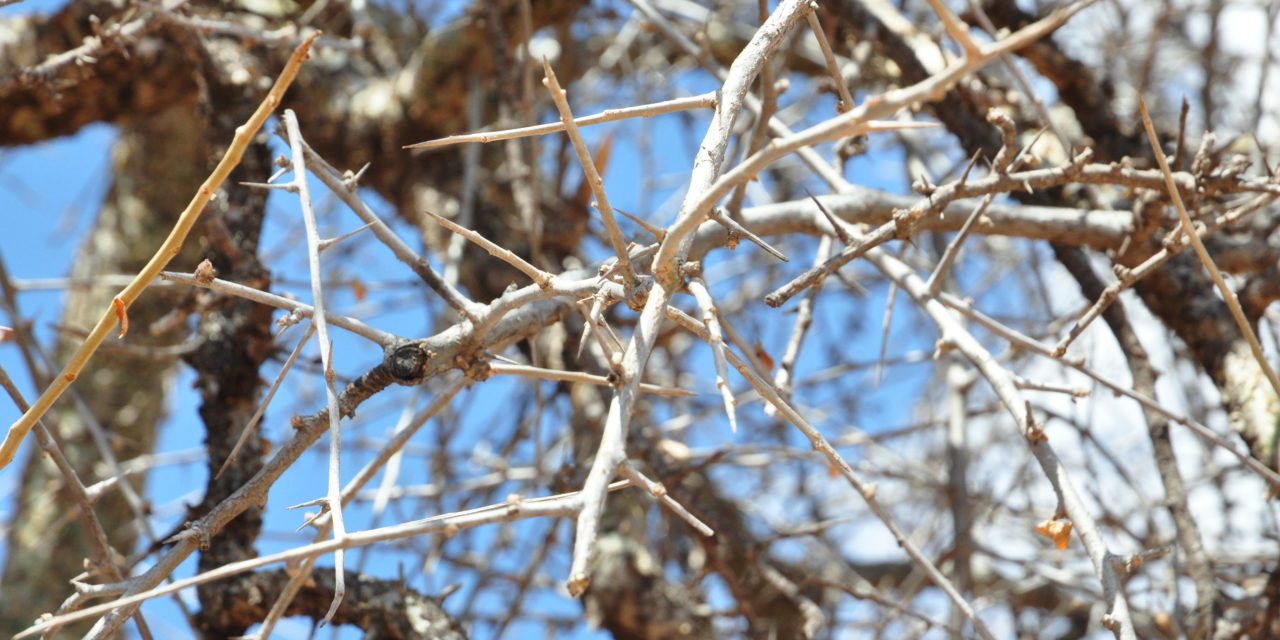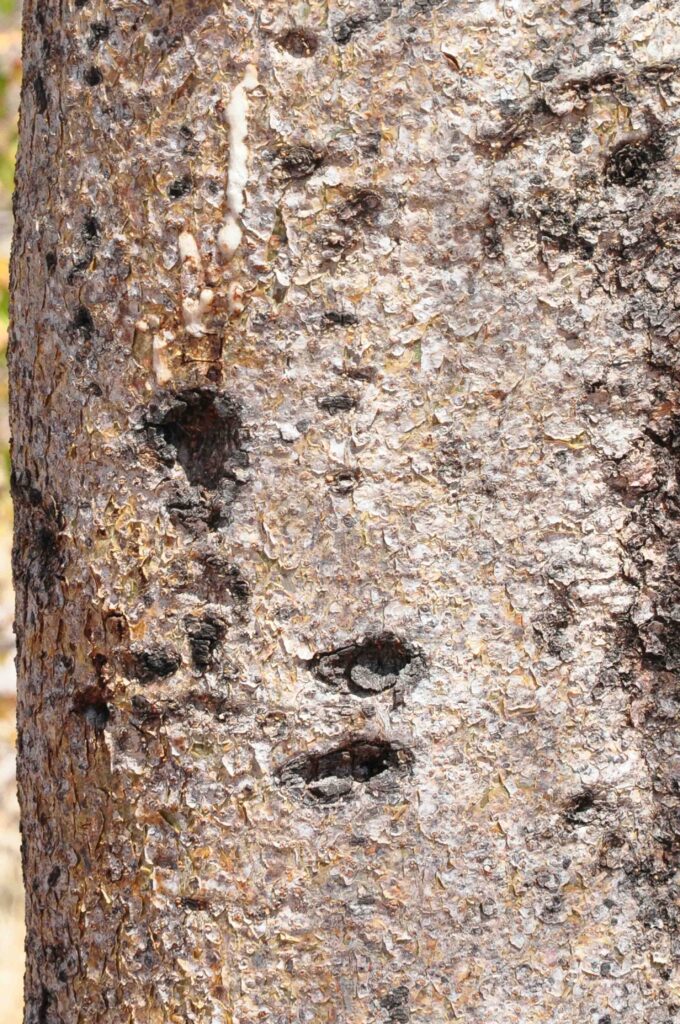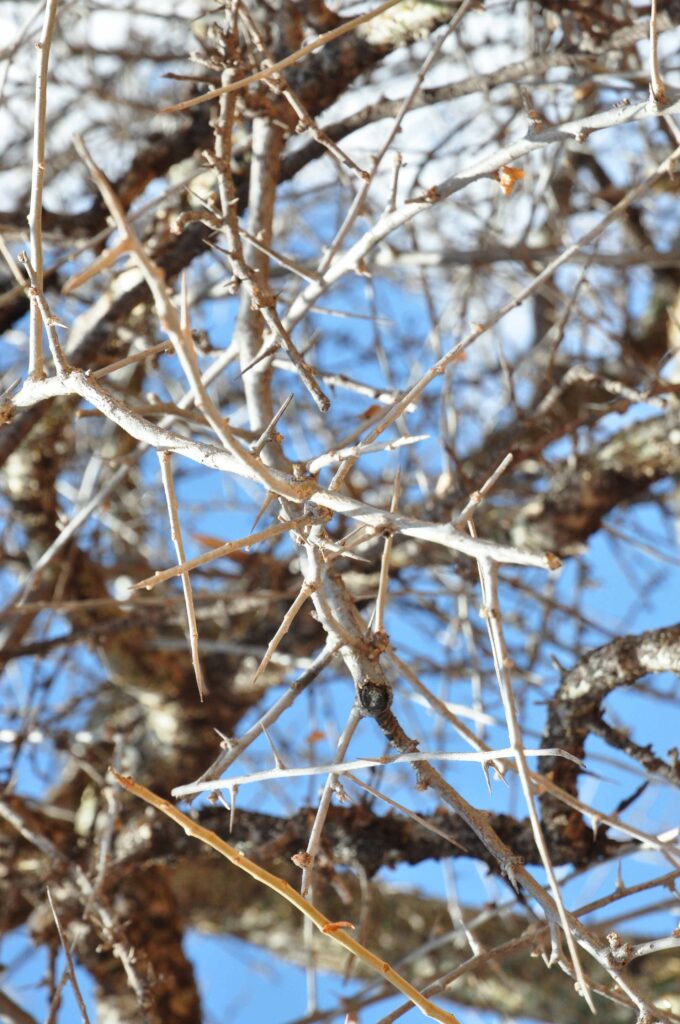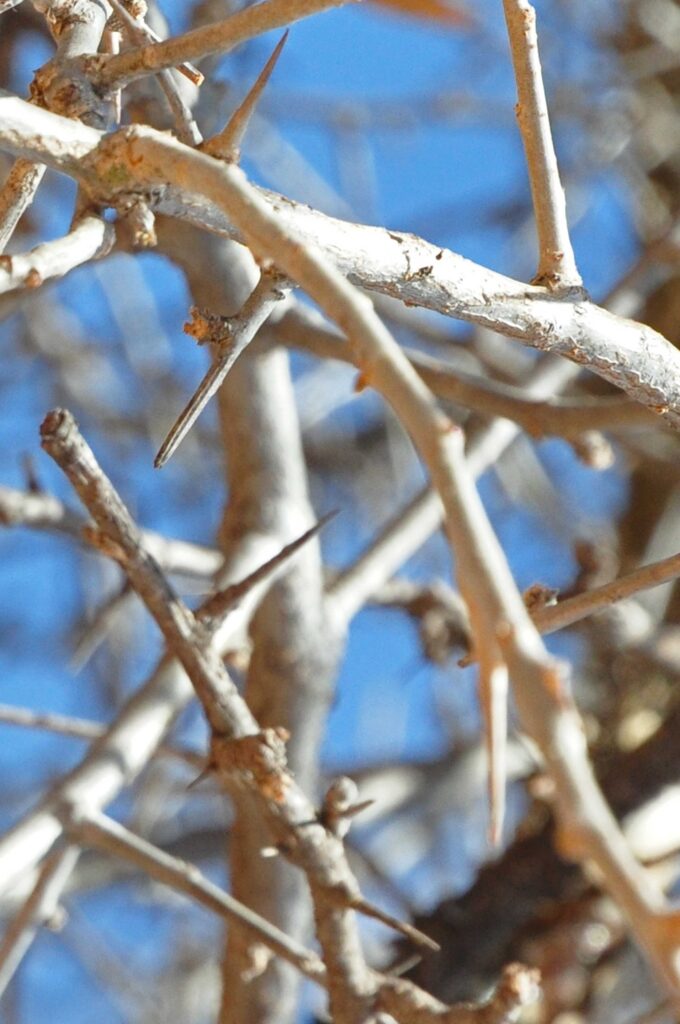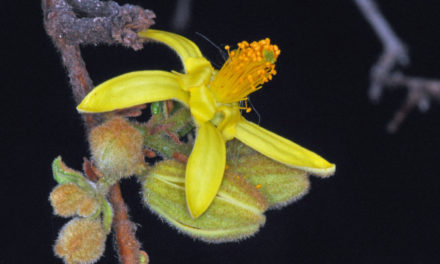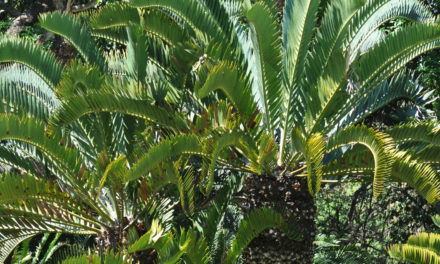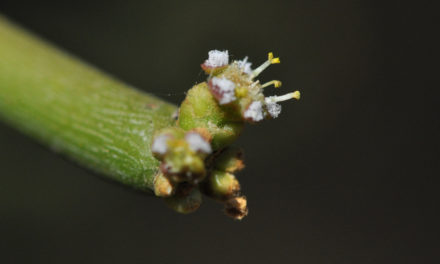General Info – summary
This resinous Tree has a single trunk up to 6m high and spines are present. Leaves are simple (usually) or trifoliate. This dioecious tree has small unisexual, regular, 4-merous, bell-shaped and yellowish Flowers. In male flowers, the 8 stamens are in 2 whorls and staminodes are present in female flowers. The edible, hairless, and ellipsoidal Fruit is an almost spherical and fleshy drupe. Black seeds have pseudo arils.
Description
Commiphora viminea
Previous Names: Commiphora merkeri.
SA Tree No. 279.
Common names: (Afr) Ringbas-kanniedood, Sebrastamkanniedood, Zebrabas-kanniedood. (Eng) Zebra Commiphora, Zebra Tree, Zebra-bark Corkwood, Zebra-barked Corkwood. (Tshivenda) Mutonyombidi. (Xitsonga) Xifati.
Family: Burseraceae (The torchwood family, which includes frankincense from Boswellia sacra, myrrh from Commiphora myrrha both of which have an incense like odour). Neither Boswellia species nor Commiphora myrrha are indigenous in southern Africa. Non-allergenic resin occurs in most plant tissues. Worldwide there are about 16 genera and in excess of 500 species, which occur in tropical South America, Malaysia and Africa. In South Africa Commiphora is the only genus and there are about 20 species that may be regarded as trees. The Bark is smooth, aromatic and pealing or flaking. The Leaves are resinous and usually without stipules. The usually dioecious Flowers have 4 or 5 petals and sepals that are imbricate (having regularly arranged, overlapping edges, as roof tiles). Flowers are actinomorphic (regular, symmetric) and the Stamens are double or equal to the number of petals. The superior Ovary has 3-5 carpels with 2 ovules in each and the single Style ends in a capitate (forms like a head) or lobed Stigma. The pitted Fruit is often an edible drupe.
Name derivation: Commiphora – Greek: kommi – gum and phora – bearer. viminea – with long flexible shoots.
Conservation: National Status: L C. (Least Concern). Assessment: 2017 (L. von Staden).
Tree
This usually single stemmed tree may reach 6m in height. The mature upright Trunk has a grey or yellowish/golden Bark (photo 253) which is patterned horizontally with large, bulging, rough black strips of Lenticels (usually raised corky oval or elongated areas on the plant that allows the uncontrolled interchange of gases with the environment). They resemble zebra markings – hence the common names. These markings make this Tree easier to identify (photo 253). Between these rough strips, the bark tends to flake in paper-like pieces. The purplish Branches are smooth and single Spines tipped (photo 254) together with leaves on dwarf shoots. Spines also occur on Commiphora ugogensis (to the north of South Africa) but are not common in other SA species of Commiphora. Resin ducts are present in the bark and help to make the bark aromatic.
- 253 2014/09/01 Mapungubwe. Photo: David Becking.
- 254 2014/09/01 Mapungubwe Photo: David Becking.
- 254E 2014/09/01 Mapungubwe Photo: David Becking.
Leaves
This deciduous tree may be leafless from June to September. The tightly clustered leaves develop on spine-tipped dwarf lateral branches and up to 4,5 x 2,5cm. The often-pear-shaped Leaves are usually simple (have a single blade, which may have incisions that are not deep enough to divide the leaf into leaflets). The single leaf is obovate, narrowly obovate or elliptic. Leaves are bluish green above and have a distinctive greyish bloom. The often-rounded Apex may taper slightly. The Base tapers and has long glandular hairs. The leaf Margin is scalloped – especially towards the apex. The Petiole (leaf stalk) is very short or absent. The very few Trifoliate leaves (compound leaves with 3 leaflets), occur on long shoots, and here the leaflets are very small.
Flowers
The trees are dioecious (unisexual floral structures with functional male and female parts on separate plants). The unisexual, Flowers appear shortly before or with the new leaves on spur branches. Flowers are tiny, about 3mm long, bell shaped and yellowish. They develop in small flowerheads in leaf axils. Flowers are 4-merous, located in small flower heads in leaf axils and are actinomorphic (Regular, symmetrical. Flowers are vertically divisible into similar halves by more than 1 plane passing through the axis). The hairless Calyx has 4 Sepals that are joined at the base. The Corolla has 4 Petals which alternate with the sepals and are tubular at the base. A cylindrical Disc (a more or less fleshy or elevated development of the receptacle) is present. The Male flowers are usually larger than the female flowers. Here the 8 Stamens are in 2 whorls. The outer 4 stamens are opposite the petals and are longer than those in the inner whorl. The Anthers are introrse (turned or faced inward or toward the axis) and have longitudinal slits. The ovary is rudimentary. The Female flowers have staminodes (sterile stamens) present. There is a single pistil (a unit of the Gynoecium, the female element of the flower, composed of the Ovary, Style and Stigma) and the superior Ovary has 2 locules. The single Style ends in a capitate (forms like a head) or lobed Stigma. (Nov-Jan).
Fruit
The nearly ellipsoidal fleshy Fruit is a slightly pointed to almost spherical Drupe (or stone fruit and is a fleshy, indehiscent fruit). These hairless fruits may reach 1,3cm long, are reddish brown when ripe and split to reveal the yellow 3-4 lobed, finger like Arilode (false-aril – a structure in certain seeds that resembles an aril but is develops from the micropyle of the ovule as opposed to the stalk). This red arilode almost surrounds and covers the black Seed). (Nov-Mar).
Distribution & Ecology
These Trees are often associated with Mopane woodlands (Colophospermum mopane) and are widespread in Limpopo – north of the Soutpansberg e.g., hot mineral springs in Tshipise (Chipisi). These hot springs also provide a refuge for swallows. The trees also occur in Mapungubwe National Park. These plants are scattered in Mpumalanga. Beyond SA, they occur in eastern Botswana, Zimbabwe, Mozambique, northern Namibia, Tanzania, Kenya, and into tropical Africa. They do well in mixed deciduous woodlands and are often found in soils that are sandy and granitic (an igneous rock that develops underground when silica rich molten rock cools). Trees usually occur at low altitude in dry, hot areas and are often associated with Colophospermum mopane. Birds eat the Fruit, and many animals browse the Leaves.
Ethnobotany
The Wood is soft and of little use to man. Planted Seeds are quick growing and achieve the best results. Reports suggest that the Stem may have some anti-cancer properties. This plant is easy to grow from seeds. Local medicine makes some use of it.
References
Burrows, J.E., Burrows, S.M., Lotter, M.C. & Schmidt, E. 2018. Trees and Shrubs Mozambique. Publishing Print Matters (Pty) Ltd. Noordhoek, Cape Town.
Coates Palgrave, M. 2002. Keith Coates Palgrave Trees of Southern Africa, edn 3. Struik, Cape Town.
Lawrence, G. H. M, 1951. Taxonomy of Vascular Plants, The Macmillan Company, New York. Tenth Printing 1965.
Palmer, E. & Pitman, N. 1972. Trees of southern Africa, Balkema, Amsterdam, Cape Town.
Schmidt, S. Lotter, M. & McCleland, W. 2002. Trees and Shrubs of Mpumalanga and the Kruger National Park.
von Staden, L. 2017. Commiphora viminea Burtt Davy. National Assessment: Red List of South African Plants version 2020.1. Accessed on 2023/01/16.
http://sagr.co.za/forum/viewtopic.php?p=230593
http://www.zimbabweflora.co.zw/speciesdata/species.php?species_id=133410
https://www.ncbi.nlm.nih.gov/pubmed/18640253
http://www.nbri.org.na/sites/default/files/treeatlas/pdf/TAP_Commiphora%20discolor.pdf
http://posa.sanbi.org/flora/browse.php?src=SP

